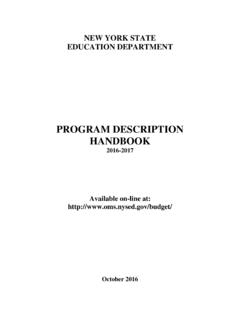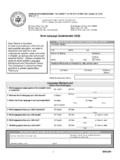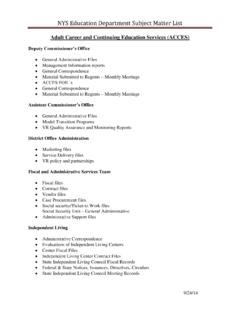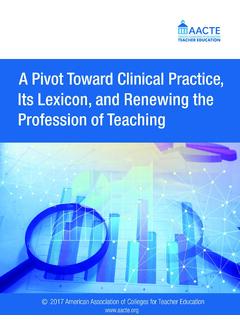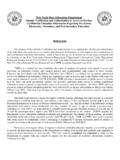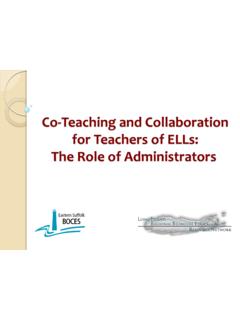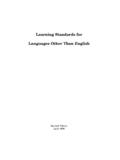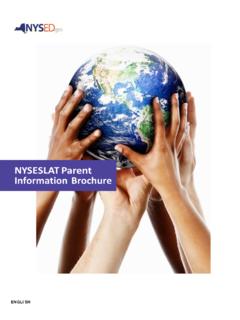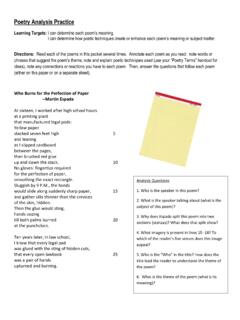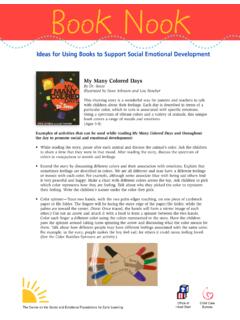Transcription of PK2 Next Generation ELA Standards at a Glance
1 NYSED PK-2 Next Generation ELA Standards at a Glance 1 PK-2 Next Generation ELA Standards at a Glance PK-2 Reading Standards (Literary and Informational Text) Review the PK, K, 1st, and 2nd grade ELA introductions for information regarding: guidance and support, range of student reading experiences, text complexity, English language learners/multilingual learners, and students with disabilities. Key Ideas and Details PK K 1 2 PKR1: Participate in discussions about a text. KR1: Develop and answer questions about a text. 1R1: Develop and answer questions about key ideas and details in a text. 2R1: Develop and answer questions to demonstrate an understanding of key ideas and details in a text. PKR2: Retell stories or share information from a text. KR2: Retell stories or share key details from a text. 1R2: Identify a main topic or central idea in a text and retell important details.
2 2R2: Identify a main topic or central idea and retell key details in a text; summarize portions of a text. PKR3: Develop and answer questions about characters, major events, and pieces of information in a text. KR3: Identify characters, settings, major events in a story, or pieces of information in a text. 1R3: Describe characters, settings, and major events in a story, or pieces of information in a text. 2R3: In literary texts, describe how characters respond to major events and challenges. In informational texts, describe the connections among ideas, concepts, or a series of events. Craft and Structure PK K 1 2 PKR4: Exhibit an interest in learning new vocabulary. KR4: Identify specific words that express feelings and senses . 1R4: Identify specific words that express feelings and senses . 2R4: Explain how words and phrases in a text suggest feelings and appeal to the senses .
3 PKR5: Interact with a variety of genres. KR5: Identify literary and informational texts. 1R5: Identify a variety of genres and explain major differences between literary texts and informational texts. 2R5: Describe the overall structure of a text, including describing how the beginning introduces the text and the ending concludes the text. PKR6: Describe the role of an author and illustrator. KR6: Name the author and illustrator and define the role of each in presenting the ideas in a text. 1R6: Describe how illustrations and details support the point of view or purpose of the text. 2R6: Identify examples of how illustrations, text features, and details support the point of view or purpose of the text. Integration of Knowledge and Ideas PK K 1 2 PKR7: Describe the relationship between illustrations and the text. KR7: Describe the relationship between illustrations and the text.
4 1R7: Use illustrations and details in literary and informational texts to discuss story elements and/or topics. 2R7: Demonstrate understanding of story elements and/or topics by applying information gained from illustrations or text features. Begins in Kindergarten KR8: Identify specific information to support ideas in a text. 1R8: Identify specific information an author or illustrator gives that supports ideas in a text. 2R8: Explain how specific points the author or illustrator makes in a text are supported by relevant reasons. PKR9: Make connections between self, text, and the world. KR9: Make connections between self, text, and the world. 1R9: Make connections between self and text (texts and other people/world). 2R9: Make connections between self and text (texts and other people/world). NYSED PK-2 Next Generation ELA Standards at a Glance 2 PK-2 Reading Standards (Foundational Skills) Review the PK, K, 1st, and 2nd grade ELA introductions for information regarding: guidance and support, range of student reading experiences, text complexity, English language learners/multilingual learners, and students with disabilities.
5 Print Concepts PK K 1 2 PKRF1: Demonstrate understanding of the organization and basic features of print. PKRF1a: Recognize that words are read from left to right, top to bottom and page to page. PKRF1b: Recognize that spoken words are represented in written language. PKRF1c: Understand that words are separated by spaces in print. PKRF1d: Recognize and name some upper/lowercase letters of the alphabet, especially those in own name. PKRF1e: Recognize that letters are grouped to form words. PKRF1f: Differentiate letters from numerals. PKRF1g: Identify front cover and back cover. KRF1: Demonstrate understanding of the organization and basic features of print. KRF1a: Follow words from left to right, top to bottom, and page by page. KRF1b: Recognize that spoken words are represented in written language by specific sequences of letters.
6 KRF1c: Understand that words are separated by spaces in print. KRF1d: Recognize and name all upper- and lowercase letters of the alphabet. KRF1e: Identify the front cover, back cover, and title page of a book. 1RF1: Demonstrate understanding of the organization and basic features of print. 1RF1a: Recognize the distinguishing features of a sentence ( , first word, capitalization, ending punctuation). Print Concept Standards are addressed in Prekindergarten Grade 1. Please see preceding grades for more information. Phonological Awareness PK K 1 2 PKRF2: Demonstrate an emerging understanding of spoken words, syllables, and sounds (phonemes). PKRF2a: Begin to recognize and match spoken words that rhyme ( songs, chants, finger plays). PKRF2b: Begin to recognize individual syllables within spoken words ( cup cake, base ball).
7 PKRF2c: Isolate and pronounce the initial sounds (phonemes) in spoken one- syllable words ( the /m/ in map). KRF2: Demonstrate understanding of spoken words, syllables, and sounds (phonemes). KRF2a: Recognize and produce spoken rhyming words. KRF2b: Blend and segment syllables in spoken words. KRF2c: Blend and segment onsets and rimes of spoken words. KRF2d: Blend and segment individual sounds (phonemes) in spoken one-syllable words. KRF2e: Create new words by manipulating the phonemes orally in one-syllable words. 1RF2: Demonstrate understanding of spoken words, syllables, and sounds (phonemes). 1RF2a: Count, blend and segment single syllable words that include consonant blends. 1RF2b: Create new words by manipulating individual sounds (phonemes) in spoken one-syllable words. 1RF2c: Manipulate individual sounds (phonemes) in single-syllable spoken words.
8 Phonological Awareness Standards are addressed in Prekindergarten Grade 1. Please see preceding grades for more information. NYSED PK-2 Next Generation ELA Standards at a Glance 3 PK-2 Reading Standards (Foundational Skills, continued) Review the PK, K, 1st, and 2nd grade ELA introductions for information regarding: guidance and support, range of student reading experiences, text complexity, English language learners/multilingual learners, and students with disabilities. Phonics and Word Recognition PK K 1 2 PKRF3: Demonstrate emergent phonics and word analysis skills. PKRF3a: Demonstrate one-to-one letter-sound correspondence by producing the primary sound of some consonants. KRF3: Know and apply phonics and word analysis skills in decoding words. KRF3a: Demonstrate one-to-one letter-sound correspondence by producing the primary sound or most frequent sound for each consonant.
9 KRF3b: Decode short vowel sounds with common spellings. KRF3c: Decode some regularly spelled one-syllable words. KRF3d: Read common high-frequency words by sight. 1RF3: Know and apply phonics and word analysis skills in decoding words. 1RF3a: Know the letter-sound correspondences for common blends and consonant digraphs ( , sh, ch, th). 1RF3b: Decode long vowel sounds in regularly spelled one-syllable words ( , final -e conventions and common vowel teams). 1RF3c: Decode regularly spelled one-syllable words. 1RF3d: Determine the number of syllables in a printed word by using knowledge that every syllable must have a vowel sound. 1RF3e: Decode two-syllable words following basic patterns by breaking the words into syllables. 1RF3f: Recognize and identify root words and simple suffixes ( run, runs, walk, walked). 1RF3g: Read most common high-frequency words by sight.
10 2RF3: Know and apply phonics and word analysis skills in decoding words. 2RF3a: Distinguish long and short vowels when reading regularly spelled one-syllable words (including common vowel teams). 2RF3b: Decode short and long vowel sounds in two-syllable words. 2RF3c: Decode regularly spelled two-syllable words. 2RF3d: Recognize and identify root words and common suffixes and prefixes. 2RF3e: Read all common high-frequency words by sight. Fluency PK K 1 2 PKRF4: Displays emergent reading behaviors with purpose and understanding. KRF4: Will engage with emergent-reader texts and read-alouds to demonstrate comprehension. 1RF4: Read beginning reader texts, appropriate to individual student ability, with sufficient accuracy and fluency to support comprehension. 1RF4a: Read beginning reader texts, appropriate to individual student ability, orally with accuracy, appropriate rate, and expression on successive readings.
